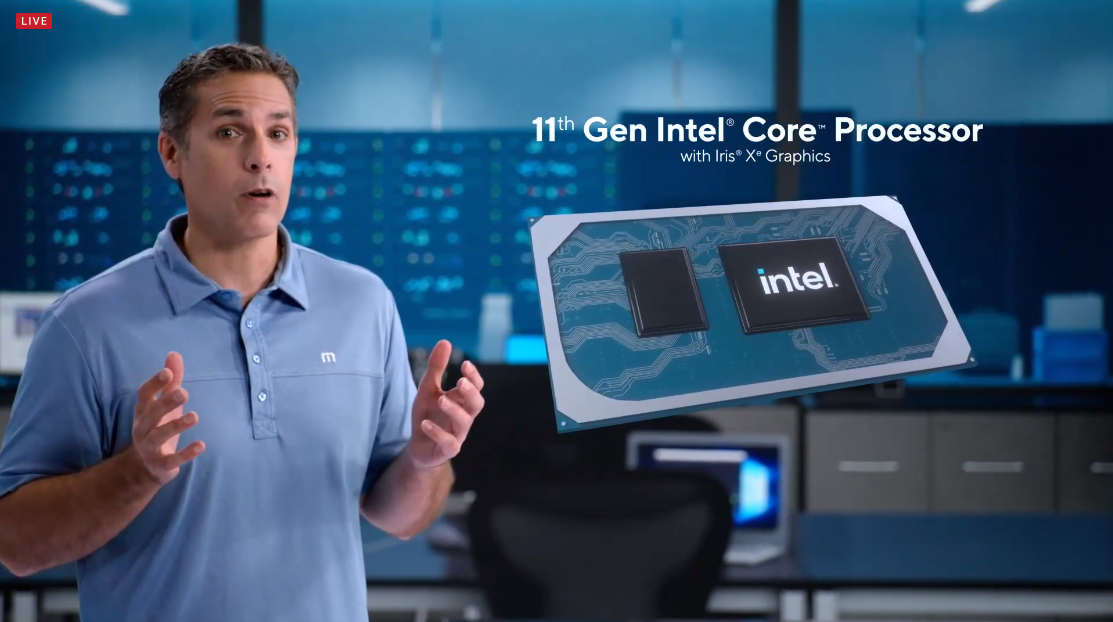Intel reveals 11th-Gen Tiger Lake CPUs and Xe graphics — here are the key features
Intel's hottest new chips are packed with more power and better features than ever, and they're coming this fall

Intel has announced it's hotly anticipated Tiger Lake processors, ushering in the 11th generation of Intel processors, along with a slew of new technologies and features. The new processors promise improvements across the board – with faster performance, better battery life and more capability for everything from content creation to gaming, all in a more portable package.
Today, Intel announced new 11th-gen models of Core i3, Core i5 and Core i7 processors for ultraportable laptops, with more than 50 new models coming in time for the holidays, and more than 150 total new designs coming from Acer, Asus, Dell, Dynabook, HP, Lenovo, LG, MSI, Razer, Samsung and others.
- The best laptops we've reviewed
- Intel Tiger Lake 11th Gen CPUs: release date, specs and more
Major changes at 10 nanometers
For this newest batch of processors, Intel has moved to a 10 nanometer fabrication process, which allows more tightly packed transistors, which in turn means faster performance, lower power requirements and more overall power packed into the same or smaller chip size.
But Intel's new designs didn't stop there. First, the y new CPUs feature Intel's SuperFin technology, which squeezes higher performance out of each transistor, getting the same performance with less voltage — a move that will directly improve battery life.
Intel engineers also reworked the CPU's metal stack, the layers of the three-dimensional circuits that make up the processor. By optimizing these layers for performance and power efficiency, this further reduces the power requirements of the new processors, while also delivering faster performance.
Intel claims that those enhancements combine to deliver 20% faster performance, with twice the graphics capability of 10th-generation chips and 5x improvement in AI performance.
Those two key improvements — lower power consumption and faster performance — are the key to any new processor, but Intel has also outfitted the 11th-Gen CPUs with less abstract enhancements.
Sign up to get the BEST of Tom's Guide direct to your inbox.
Get instant access to breaking news, the hottest reviews, great deals and helpful tips.
New PC features come standard
Among them, the new chips have integrated support for Thunderbolt 4, which greatly expands the bandwidth offered over the single connection, and supports PCIe Gen4, with support for up to four 4K displays at a time.
Internet connectivity is also set to see major enhancements, with integrated Wi-Fi 6 support, delivering faster connectivity for your laptop and even better battery life thanks to smarter connection management.
All of these features combine to promise faster processing and greater overall capability than ever before.
More power on display
During the launch event stream, Intel showed demonstrations of the new 11th-Gen processors in various uses, from photo retouching to gaming.
One such demo compared 11th-Gen against AMD 4800U in photo retouching, colorizing and upscaling images using Topaz Gigapixel AI. The Intel system handled the task in under 40 seconds, while the AMD took more than 2 minutes.
Another demonstration showed gaming on integrated graphics compared to AMD 4800U and Nvidia MX350 running with one of last year's 10th-gen Intel Core processors. Running the racing game GRID, the Nvidia and AMD machines produced frame rates in the low-to-mid-30s, while the new 11th-gen Intel Core CPU with Iris X Graphics hovered around 55, well above playable speeds.
Intel 11th Gen CPU specs
Intel's Core i5 and Core i7 processors have currently been announced only in quad-core models, offering up to 8 simultaneous processing threads. Cache sizes range from 8MB to 12MB, and are rated at speeds from 2 to 3 GHz at base speeds, and up to 4.8GHz Turbo.
They will also boast Intel Iris X graphics, based on the Xe Graphics architecture.
Lower-end CPUs in the Core i3 line offers dual-core processing with up to 4 processing threads, and will get Intel UHD graphics, with an updated version of the current UHD graphics solution.
11th Gen laptops
Intel promised that the new 11th-Generation processors would start shipping before the holidays, with up to 20 laptop models featuring the new hardware before the year is out, and 150 models sporting the new hardware in 2021.
While many of these are announcing today and tomorrow, we've already got details on a few upcoming systems.
Acer is set to launch the new 14-inch Acer Swift 5 ultraportable laptop this October, with a starting price of $999. Armed with Intel's 11th-generation processors and Xe graphics, it's also expected to come with a 14-inch 1920 x 1080 resolution IPS touchscreen and weigh less than 2.2 pounds.
Acer has announced that the Swift 5 will be available with up to 16GB of LPDDR4X memory, M.2 PCIe SSD storage and an optional Nvidia GeForce MX350 graphics card. Though, given the graphics capability demoed today, the newer Xe-powered graphics may leave the Nvidia card in the dust.
Lenovo is also ready to rock with the Lenovo IdeaPad Slim 9i, a 2.64-pound ultraportable that is poised to take on top performers like the Dell XPS 13. The Lenovo IdeaPad Slim 9i is a leather-clad ultraportable that's meant to compete with the Dell XPS 13. In addition to the new processor and graphics, it's set to feature a 14-inch 4K touchscreen display with HDR and Dolby Vision, sports Dolby Atmos dual front-facing speakers and will start at $1,599 when it comes to market in November.
Other models mentioned by Intel include the Samsung Galaxy Book Flex 5G and the Asus Zenbook Flip S.
Brian Westover is currently Lead Analyst, PCs and Hardware at PCMag. Until recently, however, he was Senior Editor at Tom's Guide, where he led the site's TV coverage for several years, reviewing scores of sets and writing about everything from 8K to HDR to HDMI 2.1. He also put his computing knowledge to good use by reviewing many PCs and Mac devices, and also led our router and home networking coverage. Prior to joining Tom's Guide, he wrote for TopTenReviews and PCMag.

